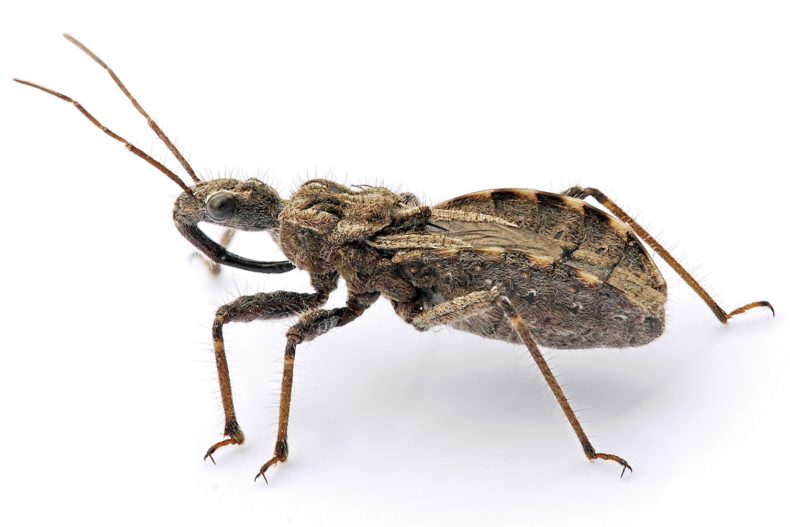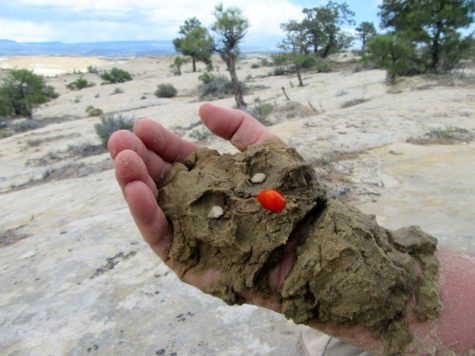
I was bitten the other night. I would have taken a picture of the turgid, blood-filled bug that stuck its rostrum inside of me for a liberal helping of hemoglobin, but my girlfriend smashed it with a rock and spattered the thing while I cheered her on. It was hard to resist the killing. Normally, I try and treat other creatures with kindness, but this one stole from me. I was glad to see it go.
The assassin bug, subfamily Triatominae, is one of the true bugs, a class of ambush predator that injects venom into prey, liquifies their interiors, and sucks them inside out. In the case of this subfamily, they are obligate blood feeders. They are also known as cone-nosed beetles, and kissing bugs, for their tendency to take blood from around the eyes or mouth of a sleeping human victim. They inject an anesthetic into the skin of the host as they feed, so at first, you don’t feel a thing.
We’d been sleeping in a sandstone alcove in southern Utah, a place where these bugs hang out to suck from woodrats that nest in the cracks between boulders. Gorgeous spot for a camp, here’s a pano of the place, our camp in the lower right:

In the morning, we found the engorged thing under her sleeping pad. It was so swollen it could barely move, a translucent red jelly bean with legs flailing for purchase. At first we didn’t know who’d been bitten, until the swelling began on my arm. By the second day, my forearm began to balloon.
According to the Encyclopedia of Entomology, “Many species are vectors of the trypanosome Trypanosoma cruzi, the etiologic agent of Chagas disease, or American trypanosomiasis.” Chagas disease. Great. This comes from a parasite the bug picks up from woodrats. It is not transferred through blood into humans, but through the assassin bug’s feces. The victim starts scratching, and parasitic eggs from bug poop are transferred from fingertips into the eyes or mouth, where the parasite can enter the host and continue its life cycle.
What worried me at the moment was not Chagas, but the pain and the size of my forearm, and the red streaks under my skin lining their way toward the inside of my elbow, the direction of my heart. As we carried our gear through canyons, I paused at waterholes to scoop up mud and pack it around the infected area. A poultice is a home remedy, nothing I learned anywhere, it just made sense. Generally, a poultice is made by mashing herbs and plant material into warm water or natural oils, applying the paste to draw out infections. The ‘herbs and plant material’ in this case were in water that had come down with the rains, and the decayed roots of horsetails mixed with whatever algae grew between the soaked sand grains.
Long before the use of penicillin, mold from bread, milk, or cheese were used as home remedies, applied to infections. Science may have perfected the treatment, but there was a time when we knew what to do from our own experiences of trial and error passed down through human history. In this case, I thought the rot at the bottom of a waterhole might help. Did it? Hard to tell. It was cool to the touch and felt good. And we gave it a face, taught it how to talk.

This isn’t a plea to protect yourself and avoid sleeping on the ground. It’s just a damn bite. Worse things are happening all the time. This is the give and take of being out there, Circle of Life and all that. I’ve slept in more alcoves than I can remember, and I will continue to do so. This sort of thing is why we live.
Day three, the swelling went down. A poultice was no longer needed. Other than the marks of the bites where the assassin bug had taken two pokes into me, the wound appears healed. Life has returned to normal. Whatever that means.
Images: Wikipedia and Daiva Chesonis
“Yuck” seems about the most appropriate comment for a bug that looks and behaves like that, Craig. I had just recently read about these bugs and the effects of their bite. Interesting that you went to the poultice remedy – it’s as if we intuit it might help.
I moved to Tucson Three years ago. To a beautiful old rock house built by a femal architect. It was cool in summer and had stunning views BUT. The assasin bug lives in pack rat piles here and travel at dusk, the older one fly. They are attracted to our lights and come they windows and doors. Not knowing this I slept with windows open. I was bitten many many times and have read of Chaga’s effects . Apparently the parasites live for years in the gut and then break loose and travel, killing the host. A supposed sign of Chagas is one eye swollen, which I have had. I’ve moved into the city because of them and now close my windows at dusk. I kill on site too.
Go get tested asap for chagas. Early treatment is key, before organ damage occurs.
“Normally, I try and treat other creatures with kindness, but this one stole from me. I was glad to see it go.” Creatures, whose territory you invade, are only safe as long as they don’t mess with you. Your girlfriend might want to keep that in mind!
Love how instinct directed you to make a positive. I got a broken leg on a Green/Colorado river trip and had similar experience. I believe that knowledge is there just under the surface.
After all these years of reading just about everything that you have published,I had gotten used to Regan’s presence.
I found the word “girlfriend” unnaturally disturbing.
My bad,of course.
The impermanence of relationships is something that I should be accustomed to. I’ve had a few. Still,one hopes.
Peace
Umm, just a question, but what about the chagas? Did you get tested? That stuff will kill you.
I don’t mean to be glib about Chagas. I’ve been bitten before by these bugs while sleeping in rock crevasses. Cases are predominantly in Latin America from a different species, and in the US a study found one case of Chagas for every 900-4,000 contacts with infected assassin bugs. Since 1955, 40 cases of Chagas have been reported from bites within the US.
Nor do I mean to be glib about having a girlfriend. To Gilberto, yes, life got turned upside down for a while there, and hope again flows freely and wildly.
guess it all depends on where you’re at, here in Florida they are almost always welcome – not so much inside (rarely ever see them indoors) but they are renowned for being “good guys” – predators of aphids, scale and other pest insects. They are actually this entomologist’s fav bug –
there is even one that covers itself with the dead carcasses of its victims as camouflage – seriously!
Thanks Craig. I enjoy your thoughts and words.
Thanks, Craig. We live near packrat and deer mice neighbors and involuntarily–but inevitably–share space with cone-nosed bugs. My husband swells into a bright red balloon animal when he’s bitten, whereas cone-nosers only leave me with small purple spots, a lopsided face, and an obsession with obliterating bug scat. (Dried excrement also attracts others–it’s a “good shelter here” sign.) We drop our bugs into a dedicated jar in the freezer. Benadryl helps with the swelling, but Chagas-bearing trypanosomes are harder to track down.